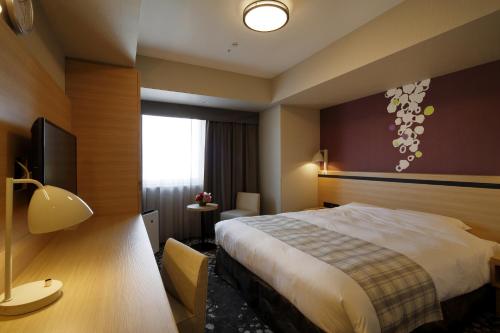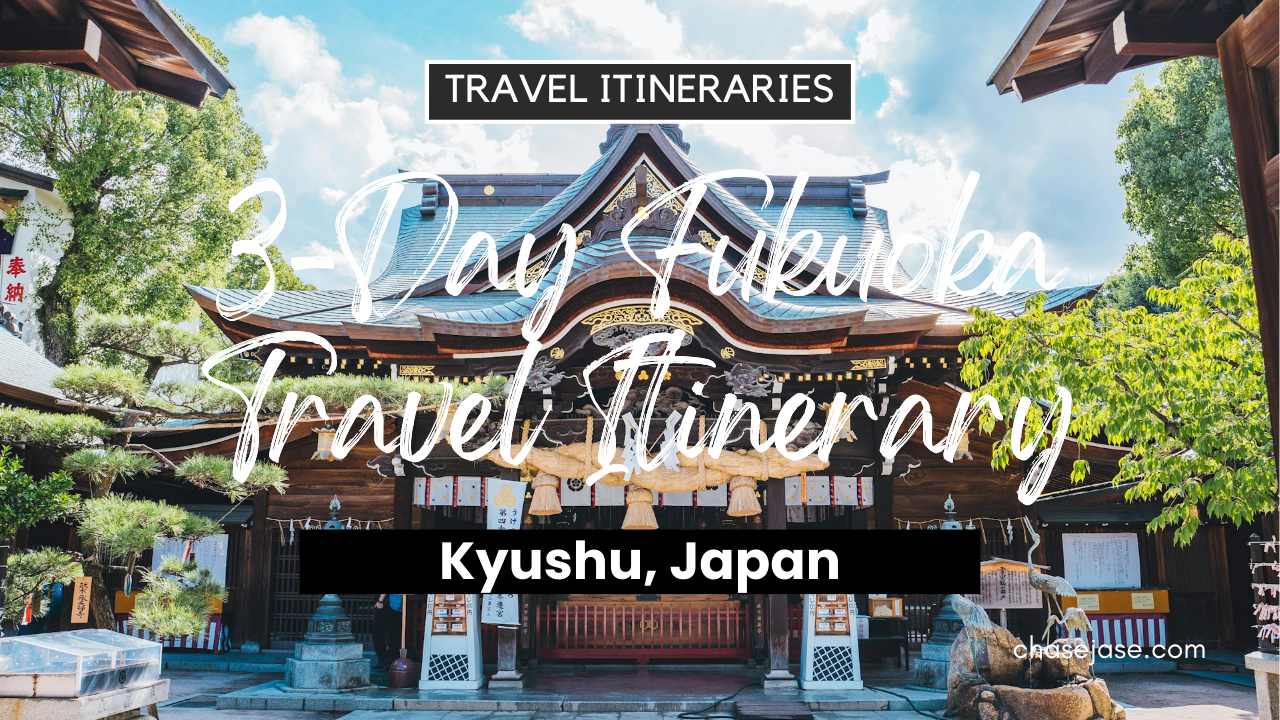3-Day Fukuoka, Japan Travel Itinerary

Introduction:
Fukuoka is a modern, vibrant city located on the northern shore of Japan’s Kyushu Island. It is the capital of Fukuoka Prefecture and is known for its unique blend of urban energy, traditional shrines, historic sites, coastal beauty, and world-renowned cuisine—especially its Hakata-style ramen. Fukuoka is also famous for its friendly locals, green parks, and accessible city layout, making it a perfect destination for a 3-day getaway in Japan.
Places to Visit:
- Ohori Park: This park is a peaceful urban retreat featuring a large pond, walking paths, and traditional Japanese gardens. It’s ideal for morning strolls or quiet reflection.
- Fukuoka Castle Ruins (Maizuru Park): These ruins are remnants of the Edo-era castle, offering great city views and cherry blossoms in spring.
- Canal City Hakata: This is a large shopping and entertainment complex with stores, restaurants, a theater, and a dynamic fountain show.
- Kushida Shrine: This shrine is one of Fukuoka’s oldest and is known for its role in the Hakata Gion Yamakasa festival.
- Hakata Machiya Folk Museum: This museum showcases Fukuoka’s traditional crafts, culture, and everyday life from the Meiji and Taisho periods.
- Tenjin Underground Shopping Mall: This mall is a stylish, vast network of boutiques and eateries located beneath the heart of downtown Fukuoka.
- Fukuoka Tower: Standing 234 meters tall, this seaside tower offers panoramic views of the city and Hakata Bay from its observation deck.
- Nanzoin Temple and Reclining Buddha: This temple is home to one of the world’s largest bronze statues, just a short train ride from central Fukuoka.
- Dazaifu Tenmangu Shrine: This shrine, dedicated to the deity of learning, is located in nearby Dazaifu and is surrounded by museums and scenic gardens.
- Momochi Seaside Park: This beachside park is perfect for sunset views, jogging, or simply relaxing near the water with Fukuoka Tower in the backdrop.

Sample Itinerary:
Day 1: Heritage and City Exploration
- 9:00 AM – Start at Ohori Park: Enjoy a 1-hour morning walk around the lake.
- 10:30 AM – Visit Fukuoka Castle Ruins (5-minute walk): Spend 45 minutes exploring the stone walls and scenic views.
- 12:00 PM – Lunch at Canal City Hakata (20-minute subway ride): Explore the mall and grab ramen at Ramen Stadium.
- 2:00 PM – Visit Kushida Shrine (10-minute walk): Spend 30 minutes admiring the shrine and its massive float.
- 3:00 PM – Explore Hakata Machiya Folk Museum (5-minute walk): Take 1 hour to understand local culture and crafts.
- 5:00 PM – Return to Tenjin area (15-minute subway): Shop at the Tenjin Underground Mall.
- 6:30 PM – Dinner at a local izakaya nearby.
Day 2: Seaside and Scenic Sites
- 9:00 AM – Head to Fukuoka Tower (20-minute bus ride): Spend 1 hour enjoying city views.
- 11:00 AM – Relax at Momochi Seaside Park (5-minute walk): Spend 1.5 hours beachside.
- 1:00 PM – Lunch at nearby seaside cafe.
- 2:30 PM – Visit Nanzoin Temple (45-minute train ride): Take 1.5 hours to see the Reclining Buddha and surrounding forest.
- 5:00 PM – Return to Hakata (45-minute train ride).
- 6:30 PM – Enjoy Yatai (street food stalls) near Nakasu for dinner.

Day 3: Culture and Temples
- 9:00 AM – Travel to Dazaifu Tenmangu Shrine (35-minute train ride): Spend 2 hours including the Kyushu National Museum.
- 12:00 PM – Lunch at a traditional soba shop in Dazaifu.
- 2:00 PM – Return to central Fukuoka (35-minute train ride).
- 3:00 PM – Free time for last-minute shopping at Tenjin or Canal City.
- 5:00 PM – Enjoy dessert or coffee at a local café before departure.
See Itinerary Map (Includes Places to Visit and Accommodations)
Best Time To Go:
The best time to visit Fukuoka is spring (March to May) and autumn (September to November). Spring is ideal because its weather is mild and cherry blossoms bloom, especially in places like Maizuru Park. Autumn offers comfortable temperatures and vibrant foliage. Summer (June–August) can be hot and humid, while winter (December–February) is cool but generally snow-free and quieter with fewer tourists.
Activities To Do:
- Eat Hakata Ramen at Ichiran or Ippudo: Fukuoka is the birthplace of this rich tonkotsu-style noodle soup. Try it at local favorites or a ramen street stall.
- Experience Yatai Culture: These are open-air food stalls unique to Fukuoka. Visitors can enjoy local delicacies and casual conversation with locals under the night sky.
- Take a Cruise on the Naka River: This 30-minute ride offers a different perspective of Fukuoka’s nightlife and city lights.
- Visit a Japanese Onsen (Hot Spring): While Fukuoka doesn’t have natural hot springs, nearby areas like Takeo or Beppu can be accessed by train for a day trip.
- Attend a Festival (Hakata Gion Yamakasa in July): This high-energy festival features men racing through the streets carrying massive floats, a unique and exhilarating local event.

Accommodations:
- Hotel Nikko Fukuoka: A luxurious stay near Hakata Station with modern amenities and fine dining.

- The Royal Park Hotel Fukuoka: A mid-range option with comfortable rooms, conveniently located close to public transit.

- Hilton Fukuoka Sea Hawk: A coastal high-rise with sea views, perfect for travelers looking for upscale comfort and amenities.

- Hotel Monte Hermana Fukuoka: A budget-friendly option near Tenjin, with clean, minimalist rooms and easy subway access.

- First Cabin Hakata: A capsule hotel offering stylish and affordable accommodations for solo travelers.

Transportation Options:
- Subway (Fukuoka City Subway): Connects key spots like the airport, Tenjin, and Hakata. It is fast, clean, and tourist-friendly.
- JR and Nishitetsu Trains: Great for intercity travel to Dazaifu, Nanzoin, and other parts of Kyushu.
- Buses (Nishitetsu Bus): A wide-ranging network that covers even less-accessible destinations within the city.
- Taxis: Convenient for short city trips, though more expensive than public transport.
- Rental Bicycles (Charichari): Perfect for exploring Tenjin or the waterfront at your own pace.
- Walking: Fukuoka’s compact city center allows for easy exploration by foot.
Tips:
- Get a Fukuoka Tourist City Pass: It gives unlimited subway and bus rides, which is ideal for exploring all parts of the city.
- Bring Cash: While many places take cards, small shops and yatai stalls may only accept yen.
- Avoid Rush Hours: Subways and buses are most crowded between 7:30–9:00 AM and 5:00–7:00 PM.
- Use Lockers at Train Stations: If you’re checking out and still exploring, coin lockers are very convenient.
- Check Festival Dates: Time your visit with a festival like Yamakasa or Dontaku for a richer cultural experience.
Fukuoka is a dynamic yet laid-back city where traditional Japanese culture and modern life beautifully coexist. This 3-day itinerary is crafted to balance food, culture, nature, and history, allowing travelers to experience the best of what the city offers. With efficient transportation, warm hospitality, and endless ramen options, Fukuoka is not just a gateway to Kyushu—it is a destination in its own right. Every day here adds a layer to your understanding of Japan’s heart beyond Tokyo and Kyoto.



